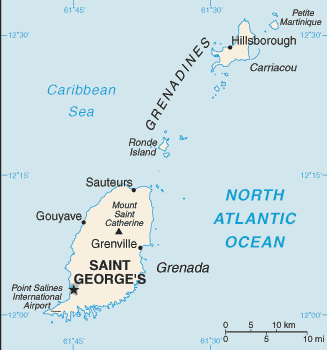|
Grenada
|

|
Capital: Saint George's
Population: 112,003
Brief History of Grenada:
Like many of the Caribbean Islands, Grenada was first inhabited by the Native American Arawak tribes who were then driven out by the warring Caribs. Christopher Columbus was the first European to discover the island. He arrived while on his third voyage to the New World in 1498. Columbus called the island ?Concepcion?, but the name didn't stick and it was later called Grenada. It's likely the name came from the Spanish city of Granada.
Due to the violent local Carib natives, the island was not settled for some time after discovery. In 1650, Cardinal Richelieu of the French purchased Grenada from the English and started the first settlement. Later in 1762, the English captured the island back from the French during the Seven Years War. The island then became a British colony.
At first the island was used for sugarcane, but later nutmeg and cacao were introduced and soon became the leading crops. Grenada is still a leading supplier of cacao and nutmeg.
Grenada gained its independence in 1974. It became one of the smallest independent countries it the Western Hemisphere.
In October 1983, Grenada was taken over by a group of Marxist communists. Six days later US forces invaded the islands. The following year, democracy and free elections were re-instituted and continue to this day.
The Geography of Grenada
Total Size: 344 square km
Size Comparison: twice the size of Washington, DC
Geographical Coordinates: 12 07 N, 61 40 W
World Region or Continent: Central America
General Terrain: volcanic in origin with central mountains
Geographical Low Point: Caribbean Sea 0 m
Geographical High Point: Mount Saint Catherine 840 m
Climate: tropical; tempered by northeast trade winds
Major cities: SAINT GEORGE'S (capital) 40,000 (2009)
The People of Grenada
Type of Government: parliamentary democracy
Languages Spoken: English (official), French patois
Independence: 7 February 1974 (from UK)
National Holiday: Independence Day, 7 February (1974)
Nationality: Grenadian(s)
Religions: Roman Catholic 53%, Anglican 13.8%, other Protestant 33.2%
National Symbol:
National Anthem or Song: Hail Grenada
Economy of Grenada
Major Industries: food and beverages, textiles, light assembly operations, tourism, construction
Agricultural Products: bananas, cocoa, nutmeg, mace, citrus, avocados, root crops, sugarcane, corn, vegetables
Natural Resources: timber, tropical fruit, deepwater harbors
Major Exports: bananas, cocoa, nutmeg, fruit and vegetables, clothing, mace
Major Imports: food, manufactured goods, machinery, chemicals, fuel
Currency: East Caribbean dollar (XCD)
National GDP: $1,440,000,000
** Source for population (2012 est.) and GDP (2011 est.) is CIA World Factbook.
Back to Geography Home Page
